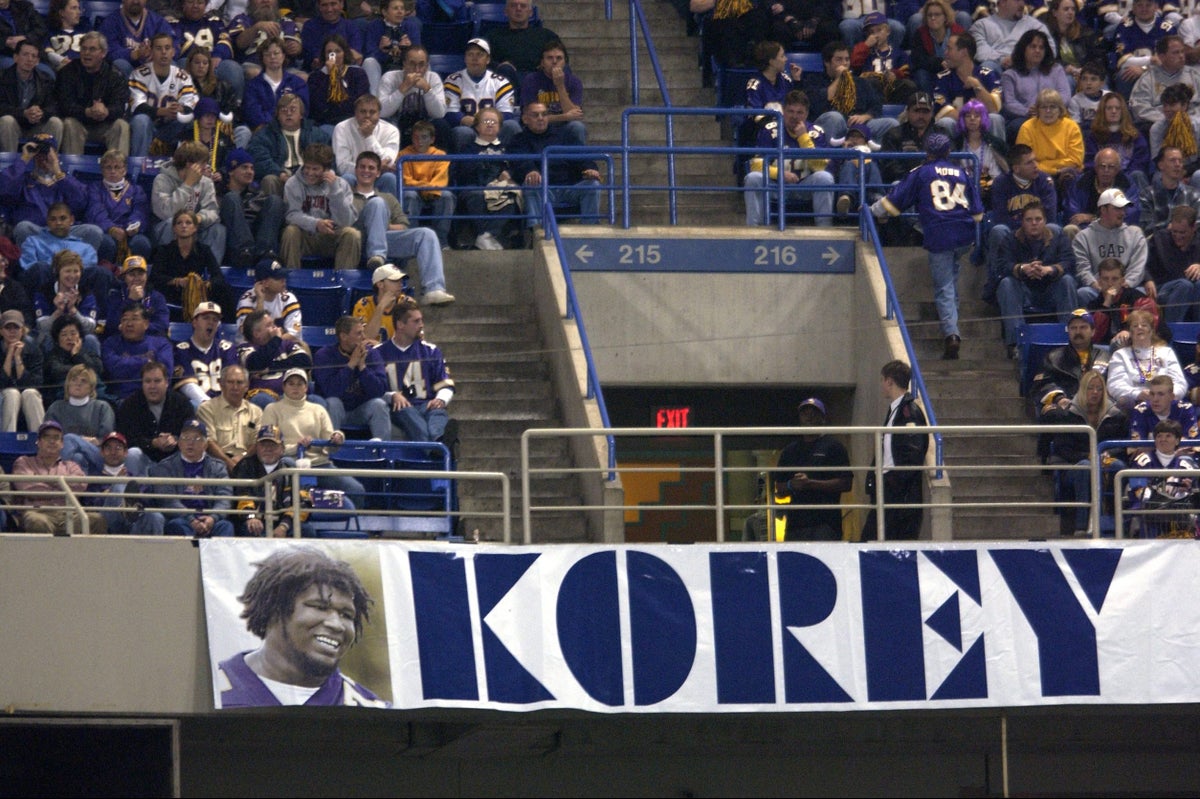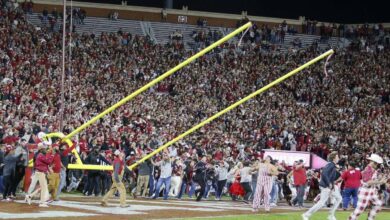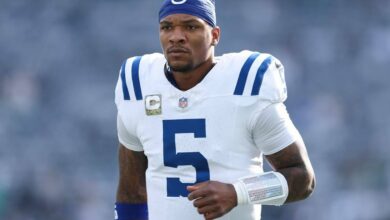Tragedy in the locker room: How 2 teams coped with the deaths of beloved teammates

COLUMBUS, Ohio — In March 1993, the morning after two of his relief pitchers died in a boating crash, then-Cleveland Indians manager Mike Hargrove arrived at the team’s spring-training facility at approximately 6 a.m. to find the parking lot full and most of the players already in the clubhouse.
The team leaders thought it was important that everybody be together as soon as possible after the deaths of Steve Olin and Tim Crews, and the task of convening a team meeting fell to Hargrove, a 43-year-old third-year manager.
“I had no clue what I was going to say or do. Where do you begin?” Hargrove said. “I said a prayer to myself that God would help and put words in my mouth to at least help us start the process of understanding and grieving.
“We went into the clubhouse and made a huge circle with chairs and I sat in the middle and started talking. When I ran out of things to say or couldn’t talk anymore, one of the players would stand up and they’d talk until they couldn’t talk. We did that for I don’t know how long, maybe two hours. It was not easy, but I think it was helpful.”
Thankfully, very few professional athletes have experienced what the Columbus Blue Jackets have been going through since the evening of Aug. 29, when Johnny Gaudreau and his brother, Matthew, died after being struck by a car while cycling — or the challenges the team will confront as the 2024-25 season is played.
But the Blue Jackets, who opened training camp this week, less than three weeks after the brothers’ deaths, aren’t alone, either, when it comes to facing tragedy this close to the start of a season.
The 1993 crash that took the lives of the two Cleveland pitchers and severely injured a third, Bob Ojeda, happened just two weeks before the start of the season. In 2001, Minnesota Vikings Pro Bowl offensive tackle Korey Stringer died on the second day of training camp in Mankato, Minn., after extreme heatstroke led to major organ failure. The Vikings’ preseason opener was just 10 days later.
Like the Gaudreaus’ death, the sudden deaths of Stringer, Crews and Olin rocked the sporting world. The aftershocks are still felt within the organizations decades later.
The Athletic spoke with players and coaches who were on those teams in Cleveland and Minnesota. They were asked about the challenges of getting back to work, the difficulty in finding motivation amid the grief, and the best way to deal with grief on the days when it seems overwhelming.
“When I heard about the (Gaudreaus), I thought first about their families,” said former Vikings tight end Byron Chamberlain, a teammate of Stringer. “I was sad for all those guys in Columbus, his teammates, but I know what they’re going through.
“That’s the kind of pain that I wouldn’t wish on anybody.”
‘The darkest day’
March 22 was Cleveland’s only off day during the entire 1993 spring training. Olin, Crews and Ojeda traveled approximately 45 minutes north of their spring training facility in Winter Haven, Fla, to enjoy the day at Crews’ ranch on Little Lake Nellie.
That evening, Crews was driving the boat with Olin and Ojeda aboard when he gunned the engine in the dark and misjudged a pier that extended 185 feet into the lake. When the boat slammed into the pier, Olin was killed instantly. Crews, whose blood-alcohol level was above Florida’s legal limit, died several hours later at a nearby hospital. Ojeda was treated for massive head injuries and spent multiple days in the hospital.
Longtime Cleveland broadcaster Jim Donovan called it “the darkest day in Cleveland sports history.” Olin, who had 29 saves the previous season, was expected to be the team’s closer. Crews was signed as a free agent away from the Los Angeles Dodgers.
The last time an active major leaguer was killed was in 1979, when Thurman Munson of the New York Yankees died in a plane crash.
“We had like 50 or 60 guys in camp,” Hargrove said. “Seeing the majority of them crying — these are grown men — was really sobering in itself. As the manager, I didn’t know what to do or what to say. It was just such a shock.”
Carlos Baerga, then an All-Star infielder, is now a Spanish-language broadcaster for the team — now known as the Guardians. When he heard about the Gaudreau tragedy, he said it immediately conjured memories of Olin and Crews’ deaths. He discussed it during his next broadcast.
“Our jobs as professional athletes, they aren’t like most jobs,” Baerga said. “We are a family. We spend more time with each other in pro sports than we do with most of the people in our lives. You get so close. I just pray for their families and for the players and the fans in Columbus.”
Hargrove said the team kept the lockers of Olin and Crews intact for several weeks after the tragedy, even traveling with their jerseys to set up lockers when they played on the road. Baerga said there were frequent reminders, too.
After a while, though, they decided it was best to not have the constant reminder, so they stopped a couple of months into the season.
Cleveland finished 10 games below .500 for a second consecutive season.
“We went through a tough time with it,” Baerga said.
Sandy Alomar, an All-Star catcher for Cleveland, still works for the club as the first-base coach and catching instructor. Even though the Guardians hold spring training in Goodyear, Ariz., now, there’s not a spring when Alomar doesn’t think about his former teammates.
“It’s a constant thought in your head that first season, at least it was in mine,” Alomar said. “You have to move forward, sure, but you just lost two brothers. It was a difficult season.”
After the tragedy, Hargrove made himself available to whoever wanted to speak. The team had a mental coach who was hired to help players with performance issues but was called into a different duty. Hargrove also leaned hard, he said, on veteran relievers Ted Power and Derek Lilliquist to help guide the rest of the players.
“It’s tough getting back to work, it really is,” Hargrove said. “But after a while, when we worked out or played a game, it was almost your time away from constantly thinking about what happened. So for some, it was a relief to get back to work or play.
“We made it our goal to play for Tim and Steve. You know that’s what they would have wanted, so that’s how we found some motivation and inspiration to play. That was genuine.”
Hargrove ended his conversation with The Athletic by asking that his cell number be shared with anybody on the Blue Jackets’ management or coaching staff who wanted to talk about the difficult process of moving forward. He was fighting emotions as he said it.
“You tell those coaches if they need anything … I don’t know if I can help, but I’ve been where they are,” Hargrove said.
‘This was different. This was forever’
The Vikings had made sweeping changes to their offensive line during the offseason, leaving Stringer — a first-round pick out of Ohio State — to anchor the line from his all-important left tackle spot. He was in the best shape of his career, and he was trying to stake his claim as a leader by toughing out early practices.
Stringer had issues on the first two days of camp, though, amid sweltering late-summer heat in Minnesota. On the second day, he tried to push through, but once again needed to leave practice early to head to the air-conditioned trainer’s tent. It was there where he soon lost consciousness.
Many Vikings players saw Stringer leave practice, but many of them were gone when he was taken by ambulance to a nearby hospital. They had no idea of the seriousness of the situation. Stringer died at approximately 2 a.m., with teammates Cris Carter, Daunte Culpepper, Randy Moss and others holding a vigil in the waiting area.
“They woke us up at 5 in the morning and brought us down to the (lobby) to tell us,” said wide receiver Chris Walsh, one of the locker-room leaders.
“It shook up our whole team,” Chamberlain said. “We were lost. We didn’t know where to go, where to look, what to do. … There’s no protocol for those moments.
“Dennis Green was our coach at the time, and he was a players’ coach, so he had a really great relationship with Korey, and he was grieving right along with us. When he spoke in front of the whole team and told us that we’d lost Big K — that’s what we called Korey, Big K — you could see in his eyes that he didn’t know what to do, either.
“And, man, when the leader is shook, when the leader is lost … it was pretty overwhelming.”
The Vikings held a memorial service for Stringer in Mankato before his body was flown to Warren, Ohio, his hometown, for a service for family and friends.
“In the NFL, you get used to saying goodbye to teammates,” Walsh said. “Every week, every season guys are coming and going, that’s just the business. But this was different. This was forever.”
The Vikings were given the next day off from practice and then returned to action. Both Walsh and Chamberlain said it was hard to concentrate and even more difficult to find motivation. It was also much quieter than usual, the whistles and the shouts a bit muted.
Chamberlain remembered that the weather, after several sweltering days in a row, finally broke in the days after Stringer’s death. The coolness felt almost eerie.
On Aug. 11, only 10 days after Stringer died, the Vikings flew to New Orleans to play their first preseason game.
“I can tell you this, there were a lot of guys who didn’t want to get on that plane,” Chamberlain said. “A lot of guys were close to Korey, close to his family, and they were still mourning. I remember watching Randy Moss come out for that game with tears in his eyes on the sidelines.”
The Vikings had played in the NFC Championship Game in two of the previous three seasons. They were two seasons removed from finishing 15-1 in the regular season.
In 2001, they plummeted to 5-11, the third-worst record in the NFC. Green was fired with one game left in the season, replaced by offensive line coach Mike Tice, who had been Stringer’s position coach.
“I don’t think we ever got over it,” Chamberlain said.
The Vikings played that season with Stringer’s No. 77 displayed on a patch on their jerseys. His jersey hung in his locker the entire season. In late November, the Vikings held a special night practice in front of fans in Minneapolis, retiring Stringer’s jersey into the club’s ring of honor.
“I’m sure the (Blue Jackets) are going through this, too, but you don’t even really think about the football for a very long time after you hear the news,” Walsh said. “You just think about his family, his young son. It’s when you get back to work that you notice the football impact, too.
“We were a vertical team. We had Randy Moss and Cris Carter, but we couldn’t protect long enough to go vertical. We had weapons that couldn’t be used, and everybody could see that. It was like this season-long reminder of what happened.”
Chamberlain was asked if he had any advice for Blue Jackets players as to how to handle the next few weeks, the following months and years. He didn’t need much time to think.
“I wish I didn’t have experience with this kind of thing,” Chamberlain said. “But I would tell them to not be afraid of going through the emotions of grieving, whatever that might be. Crying, thinking about (Gaudreau), praying, being angry … whatever it might be. Go through those emotions, don’t fight them.
“And what I would encourage everybody to do, if you need help or just want somebody to talk to, or if you’re feeling like it’s too big, that you can’t deal with it … go get help. Don’t be ashamed. Don’t be too big. Don’t let your ego or your pride stop that.
“We’re big tough professional athletes, but we’re also vulnerable human beings with emotions, just like everybody else in the world. Talk it out with each other, and talk it out with people who can help you. It’s only going to help you.”
The next steps
Soon after the Blue Jackets learned of Gaudreau’s death, general manager Don Waddell and captain Boone Jenner tried to set aside their grief long enough to discuss what first steps the organization should take.
It was decided, mostly at Jenner’s urging, that all of the Blue Jackets players who weren’t already in Columbus be asked to return to the city as soon as possible. Much like the Indians and Vikings decades earlier, Jenner wanted all of the players together, not just for the weekday morning “captain’s skates,” but to be present for each other as they grieved.
On Wednesday of this week, Waddell and new coach Dean Evason met with the media, as did veteran players Zach Werenski, Sean Monahan and Jenner. The Blue Jackets opened training camp on Thursday. They play their preseason opener on Monday in Buffalo. The regular season is just three weeks away.
“These last few weeks, I’m not going to lie, hockey’s not really on your mind,” Jenner said. “But being here all together, coming into day 1 of camp, we’re excited to get things rolling here.
“What happened with John and Matt is not something that’s going to magically go away. It’s going to be with us. It’s just kind of the new reality for us as a team. We’re not trying to park (our feelings), and say, ‘Well, now it’s the season.’ Those emotions are going to be there for a long, long time.
“Realizing that, and helping each other out when there are bad days or bad moments — there’s gonna be a lot of them — but we’re in it together.”
The Blue Jackets on Wednesday announced plans to honor the Gaudreau brothers throughout the season. They’ll wear a sticker on their helmets and a No. 13 patch — Johnny Gaudreau’s number — on their jerseys, both home and away. The first home game of the season, Oct. 15 vs. Minnesota, will be dedicated to the Gaudreaus’ honor.
“We have to play hockey,” Waddell said. “We’re not going to forget about Johnny and his family, the Gaudreau family. Everybody knows that Johnny wants them to play hockey. Meredith (Gaudreau’s widow) said it at the funeral, and everybody is rallying behind that.
“Do I think there are going to be some dark days? I won’t be surprised. But it’s our job as management, along with Dean (Evason) and the coaches, to stay on top of that and manage that.”
(Photo of banner honoring Korey Stringer in 2001: Elsa / Getty Images)




